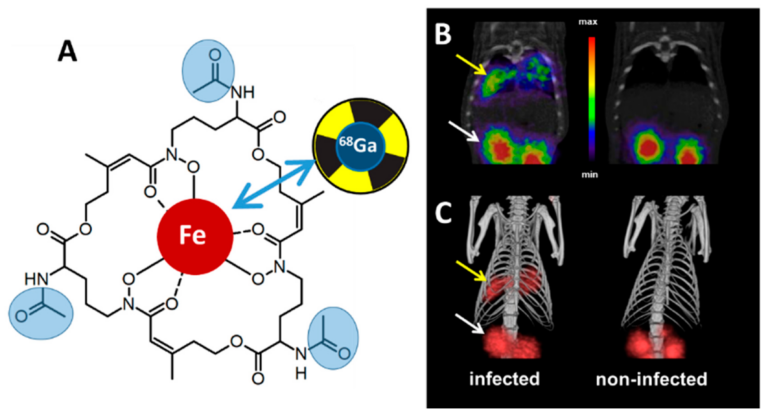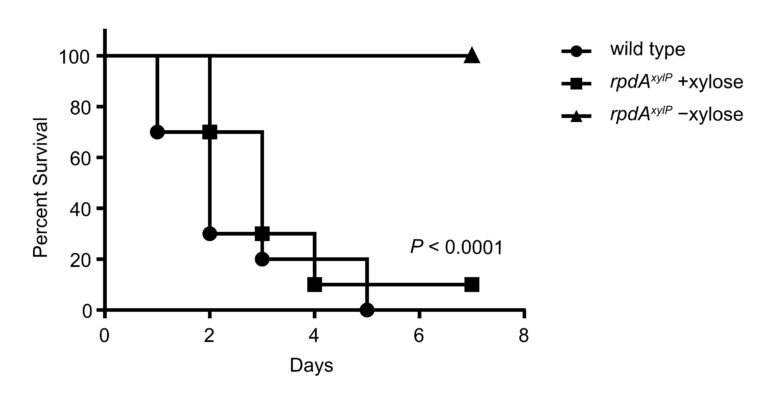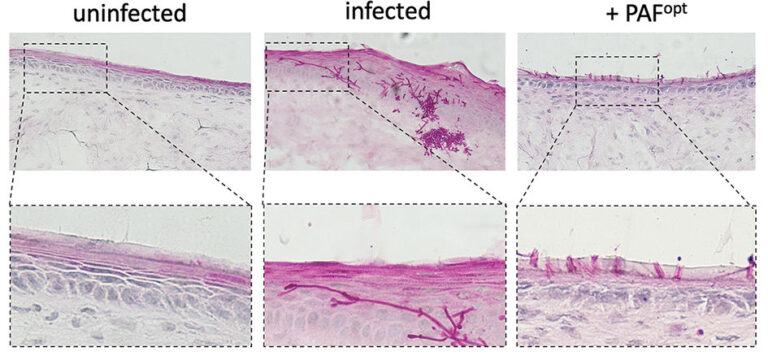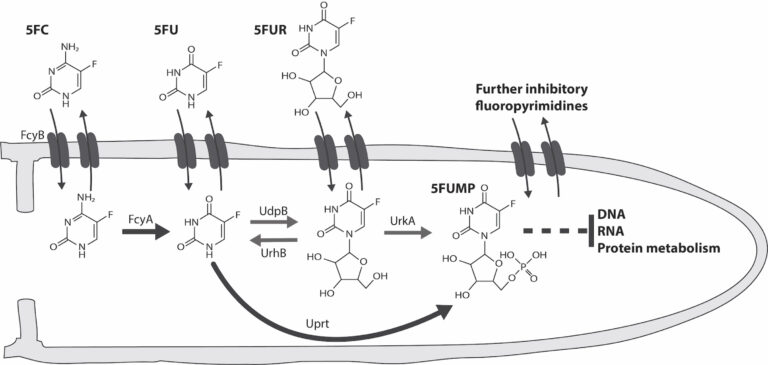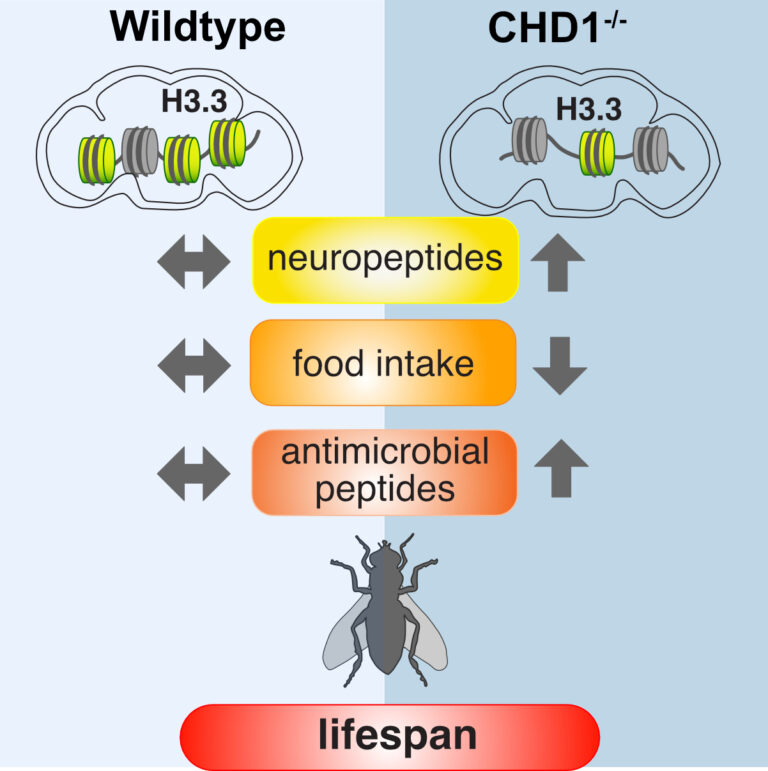
Innrain 80-82
6020 Innsbruck
Fax: +43 512900373100
Email: Hubertus.haas@i-med.ac.at
Website: https://www.i-med.ac.at/molbio/
Research year
Research Branch (ÖSTAT Classification)
106023, 106022, 106024, 301114, 303020
Keywords
antimicrobial proteins, bioactive fungal products, Chromatin and epigenetics, drug resistance, filamentous fungi, fungal infection, iron metabolism, RNA cytosine methylation, and siderophores
Research Focus
Fungal Metabolism, Gene Regulation, Virulence and Drug Resistance
- Iron metabolism in filamentous fungi: links to human disease
- Histone-modifying enzymes in gene regulation, in fungal physiology and as antifungal targets
- Structure, mechanism of action and applicability of secreted antimicrobial peptides/proteins
- Antifungal therapeutics and resistance
Epigenetics and Epitranscriptomics
- Chromatin assembly mechanisms: Chromatin remodelers and histone variants
- RNA methylation and its impact on RNA metabolism
General Facts
The Institute of Molecular Biology is home to five independent research groups; their scientific interests range from diverse aspects of filamentous fungal physiology and metabolism, antifungal and antimicrobial peptides to the nature and significance of chromatin remodelling and epitranscriptomic mechanisms. The ultimate aim of all research groups is to translate basic scientific discoveries into diagnosis and treatment of human disease. Continuous third-party funding (e.g. FWF) of all research groups and the participation of members of the institute in various intra and extramural network activities, such as the FWF-funded PhD programmes “HOROS” and “CBD”, the Euregio programme “SupErA” and the SFB “RNA Deco”, are a testament to the high standard of research. Staff members at the Institute of Molecular Biology also contribute substantially to curricular teaching and administration activities at MUI. For instance, Gerald Brosch is in charge of organising courses and student affairs for the Molecular Medicine Bachelor and Master studies. Beyond this, all group leaders and scientific staff teach lectures, seminars and practical courses as part of the human medicine, dental medicine, molecular medicine (bachelors’ and masters’) and PhD curricula.
Research
Iron Metabolism of Filamentous Fungi: Links to Human Disease
Hubertus Haas
Aspergillus fumigatus is a typical saprobic mould fungus, but also the most common human airborne fungal pathogen in Europe. Owing to unsatisfactory diagnostic and therapeutic options, it causes allergic and life-threatening invasive diseases, depending on the immune status of the patient. Our research goal is the characterisation of fungal metabolism, in order to improve antifungal therapy, the diagnosis of fungal infections and the biotechnological potential of filamentous fungi. The present research focuses on iron homeostasis-maintaining mechanisms of Aspergilli. We have demonstrated that siderophore-mediated iron acquisition and the iron-sensing transcription factor HapX are essential for virulence of A. fumigatus in murine aspergillosis models. Consequently, fungal iron metabolism represents an attractive target for the improvement of antifungal therapy and the diagnosis of fungal infections.
Major Achievements
Characterisation of siderophore-mediated iron acquisition and storage
Characterisation of fungal mechanisms for iron sensing and regulation
Metabolic linking of iron regulation, e.g. to ergosterol biosynthesis, hypoxia adaptation and leucine biosynthesis
In vivo PET (positron emission tomography) imaging of fungal infections using 68Gallium-labelled siderophores in animal models (Fig. 1, collaboration with Dr. Clemens Decristoforo, Department of Nuclear Medicine)
Proof of concept for siderophores (triacetylfusarinine C) as urine biomarkers for aspergillosis
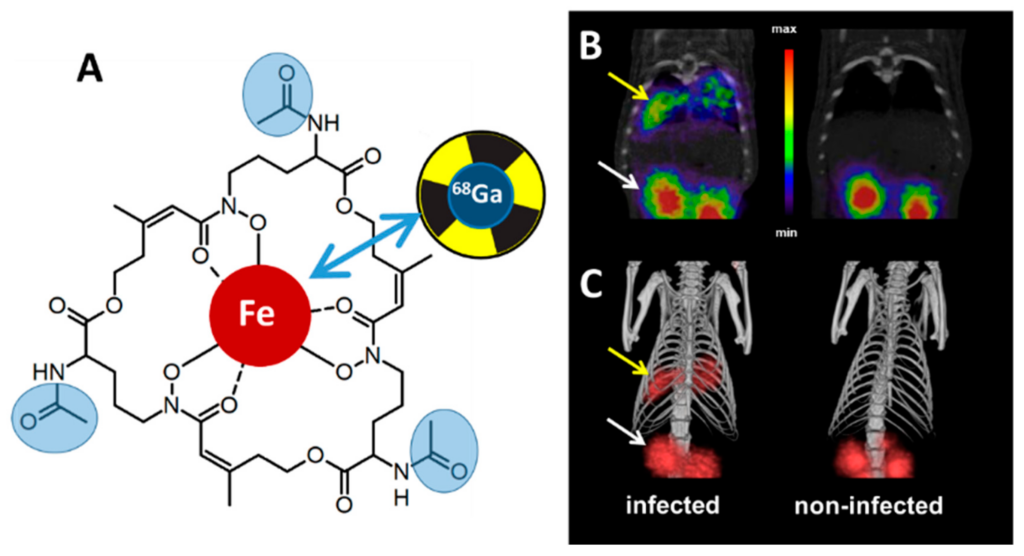
Future Goals
Further characterisation of fungal iron homeostasis and medical translation. Role of iron and siderophores in microbial interactions.
Functions of Histone-Modifying Enzymes in Gene Regulation and Fungal Physiology
Gerald Brosch, Stefan Graessle and Ingo Bauer
In addition to distinct regulatory sequences in gene promoters, the read-out of genetic information in eukaryotes is significantly controlled at the chromatin level. For instance, covalent post-translational modifications (PTMs) of histones and other proteins have profound structural and functional consequences for the transcriptional programme of a cell. Our research focuses on elucidation of the functional impact of lysine acetylation and arginine methylation on fungal physiology. Particularly, we are interested in studying the extent of the involvement of modifying activities in fungal pathogenicity as well as investigating their role in regulating secondary metabolite (SM) production. To this end, the group has generated Aspergillus strains with individual or multiple deletions respectively of all protein arginine methyltransferase (PRMT) genes and all classical lysine deacetylase (KDAC) genes. Using these tools together with specifically engineered transgenes, the impact on the viability, pathogenicity and metabolism of Aspergilli is studied. Moreover, we employ proteomic and transcriptomic analyses (i) to characterise novel substrates and (ii) to investigate the contribution of KDACs and PRMTs to the regulation of genes important for fungal virulence and SM production.
Major Achievements
KDACs: Over the past decade, we have characterised KDACs and KDAC complexes in filamentous fungi, with a special consideration of Aspergillus nidulans and its pathogenic relative Aspergillus fumigatus. Members of the genus Aspergillus play an important medical role as dreaded opportunistic pathogens or producers of allergens and highly toxic metabolites such as aflatoxins. In turn, other Aspergilli produce pharmaceutically relevant secondary metabolites (SMs) such as antibiotics or cholesterol-lowering drugs. Interestingly, KDACs play a prominent regulatory role in all those issues.
We have identified and functionally characterised two fungus-specific protein domains in the KDAC RpdA which are essential for the viability of Aspergillus in vitro and may therefore serve as antifungal targets in novel antifungal therapies. Moreover, we have confirmed RpdA as an essential fungal virulence factor in vivo in a mouse model for invasive pulmonary aspergillosis (Fig. 2)
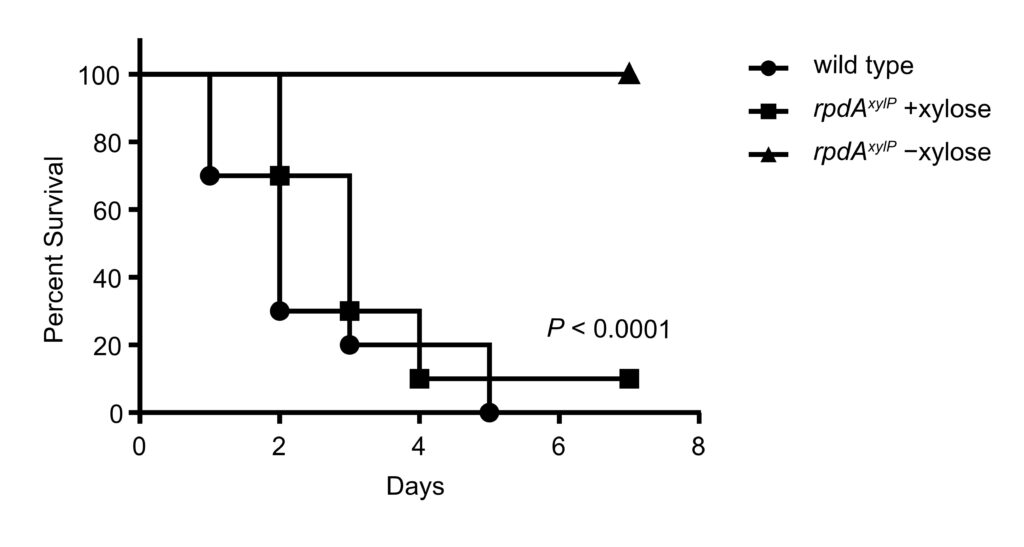
and identified a novel fungus-specific RpdA complex that is essential for sexual reproduction of the fungus. Another KDAC, HosA, was found to be a major regulator in the biosynthesis of medically important fungal secondary metabolites (e.g., toxins and antibiotics).
PRMTs: Role of protein arginine methylation in stress signalling. Functional linking of Aspergillus type I and II PRMTs to various cellular processes, including detoxification, secondary metabolism, transport and protein secretion. Identification of novel PRMT substrates involved in RNA metabolism.
Fig. 2: Downregulation of rpdA causes avirulence. Mouse survival curves (Kaplan–Meier plot) following intranasal infection of cortisone-acetate immunocompromised mice (n = 10 animals/group) with (rpdAxylP +xylose) and without (rpdAxylP−xylose) induction of fungal RpdA in vivo. A wild-type strain was used as control. Comparison of survival curves of mice infected with rpdA repressed vs. rpdA induced or wild type using the log-rank test (Mantel-Cox) revealed significance of P < 0.0001. (Bauer et al., Front. Microbiol. 2019)
Future Goals
KDACs: Using a versatile promoter system, different knock out strategies and transcriptional analyses, we intend to further unveil fungal-specific features of RpdA and HosA and will identify KDAC targets involved in virulence, resistance and SM production. In addition, we aim to clarify the composition of yet unknown fungal KDAC complexes. Screening novel synthetic KDAC inhibitors for their antifungal efficacy in vitro and in vivo in different virulence models is another interesting research topic in our laboratory.
PRMTs: Investigation of the (methyl-) proteome network
Identification and validation of reactive oxygen species (ROS) induced PRMT substrates
Functional consequences of demethylation of ROS-specific substrates
Elucidation of the biological role of as yet uncharacterised type IV PRMTs
Structure, Mechanism of Action and Applicability of Small, Cationic Antimicrobial Peptides and Proteins
Florentine Marx-Ladurner
The rise in drug resistance of human pathogenic bacteria and fungi fuels the urgency to search for alternative antimicrobial agents with novel modes of action that differ from existing ones and
hamper the onset of resistance development. Promising candidates are small, cationic antimicrobial proteins and peptides (scAMPPs) that are natural defence molecules produced byorganisms of all phyla. These scAMPPs are powerful model molecules that promise the development of new effective antimicrobial strategies for therapeutic application.
The Marx group aims to identify and isolate scAMPPs and characterise in detail their mode of action and structure-function relation. The rational design and chemical synthesis of protein and peptide analogues derived from respective natural parent molecules open up a vast field of possibilities to improve the antimicrobial efficacy and tolerance by the host and lower the risk for resistance development of pathogenic agents. In an endeavour to support the Animal Free Research Cluster of the Medical University of Innsbruck, the group aims to reduce, refine and replace animal models for early drug screening purposes. Therefore, scAMPPs are first screened in vitro for a selection of the most promising candidates before they are tested for their curative potential using in vitro 3D human reconstructed skin tissue models and in vivo invertebrate mini-host models that are infected with opportunistic human pathogens. Both models are recognised as advantageous and valid alternatives to in vivo vertebrate models. This approach helps to bridge the gap between in vitro and in vivo drug testing, reduce the number of vertebrate hosts sacrificed for drug screening purposes and lower the experimental costs.
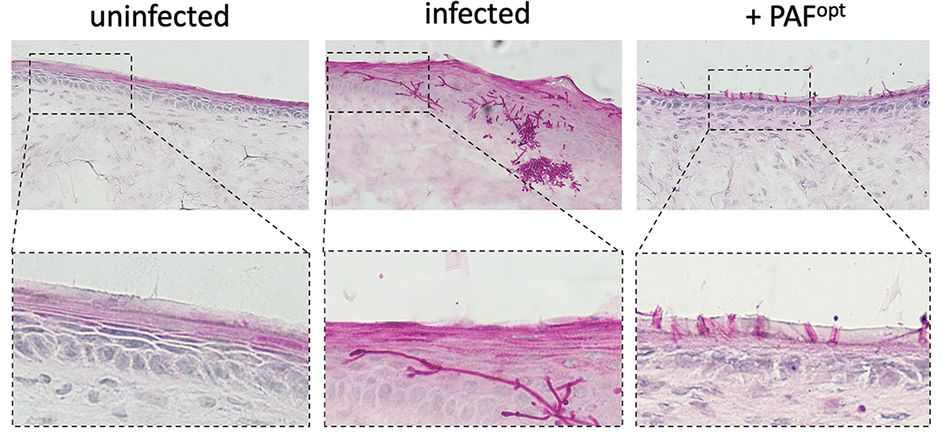
Major Achievements
Understanding the structure-function relationship of scAMPPs and first steps towards their therapeutic application.
Future Goals
Our aims are the rational design to improve the antimicrobial efficacy and species-specificity of scAMPPs and reduce the risk for resistance development in pathogenic microorganisms;
the determination of the mode of action and the identification of molecular targets of scAMPPs;
the combination of scAMPPs with smart drug delivery systems to improve the antimicrobial potential of peptide-based drugs.
Antifungal Therapeutics and Resistance
Fabio Gsaller
As fungi belong to the domain of eukaryotes, many vital processes in mammalian cells are conserved in fungal species. Hence, substances with antifungal activity often have toxic effects on human cells, which makes the development of novel antifungal drugs particularly challenging. In the clinical setting, the first-line treatment of choice for Aspergillus infections consists of azole-based antifungals. However, emerging resistance to this drug class represents a growing threat to public health.
Our research explores metabolic effects caused by antifungal drugs as well as molecular factors employed by Aspergillus fumigatus to protect itself from the action of anti-mycotic substances. In this regard, major aspects of our work involve mode-of-action determination and the investigation of gene regulatory mechanisms that drive the resistance to clinically administered anti-mycotics, which is critical for the development of alternative strategies that can be employed to treat fungal infections.
Major Achievements
Discovery of the molecular cause underlying the predominant azole resistance mechanism found in A. fumigatus . Elucidation of major mechanisms that confer intrinsic resistance to the antifungal nucleobase analogue 5-fluorocytosine (Fig. 4).
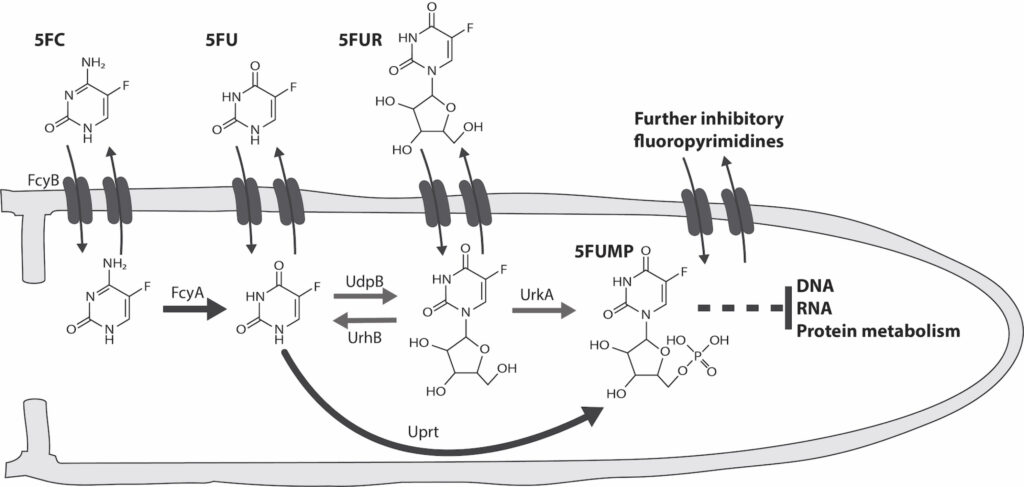
Future Goals
We aim to increase our knowledge of strategies employed by fungal pathogens to counteract the activity of antifungal drugs, with the ultimate goal of improving current approaches for the treatment of fungal infections.
Epigenetics and Epitranscriptomics
Alexandra Lusser
Eukaryotic DNA is assembled into a nucleoprotein complex called chromatin, of which the basic repeating unit is the nucleosome. The way in which DNA is organised in chromatin allows highly efficient compaction of the genetic material and provides additional levels of control in the regulation of nuclear processes, such as transcription, replication, repair and recombination. We are interested in learning how the establishment and maintenance of eukaryotic chromatin affects these processes. We are approaching this question by studying the molecular mechanisms and biological context of chromatin assembly and remodelling processes. Moreover, we are interested in “epitranscriptomic” modifications, i.e. base modifications that occur on RNA molecules and affect their fate in the cell. Major research issues in my laboratory are: (i) the study of biological functions of ATP-dependent chromatin-remodelling factor CHD1; (ii) the study of centromeric chromatin assembly in Drosophila and (iii) the analysis of 5-methylcytosine distribution and function in mammalian mRNA.
Major Achievements
We recently showed that the chromatin remodelling factor CHD1 is crucial for preserving chromatin integrity in the adult brain. Using the fruit fly as a model, we found that the absence of CHD1 in the brain results in reduced incorporation of the transcription-coupled histone variant H3.3. Consequently, chromatin loses some of its repressive qualities leading to global transcriptional upregulation and severely disturbed control of fly physiology and behaviour. Mutant flies have reduced motivation to feed, disturbed metabolic signalling and a severely reduced lifespan (Fig. 5). Moreover, CHD1 is critically involved in regulating perception, such as smell or taste. Furthermore, in collaboration with Ronald Micura’s laboratory (University of Innsbruck), we have explored strategies to optimise metabolic labelling of nascent RNA by prodrug-modification of the RNA nucleotides, 4-thiouracil (4sU) and 6-thioguanine (6sG). Rather than improvement of the labelling efficiency, however, we found several 6sG prodrugs with a high potential for application as therapeutic components in thiopurine-resistant cancers or inflammatory diseases.
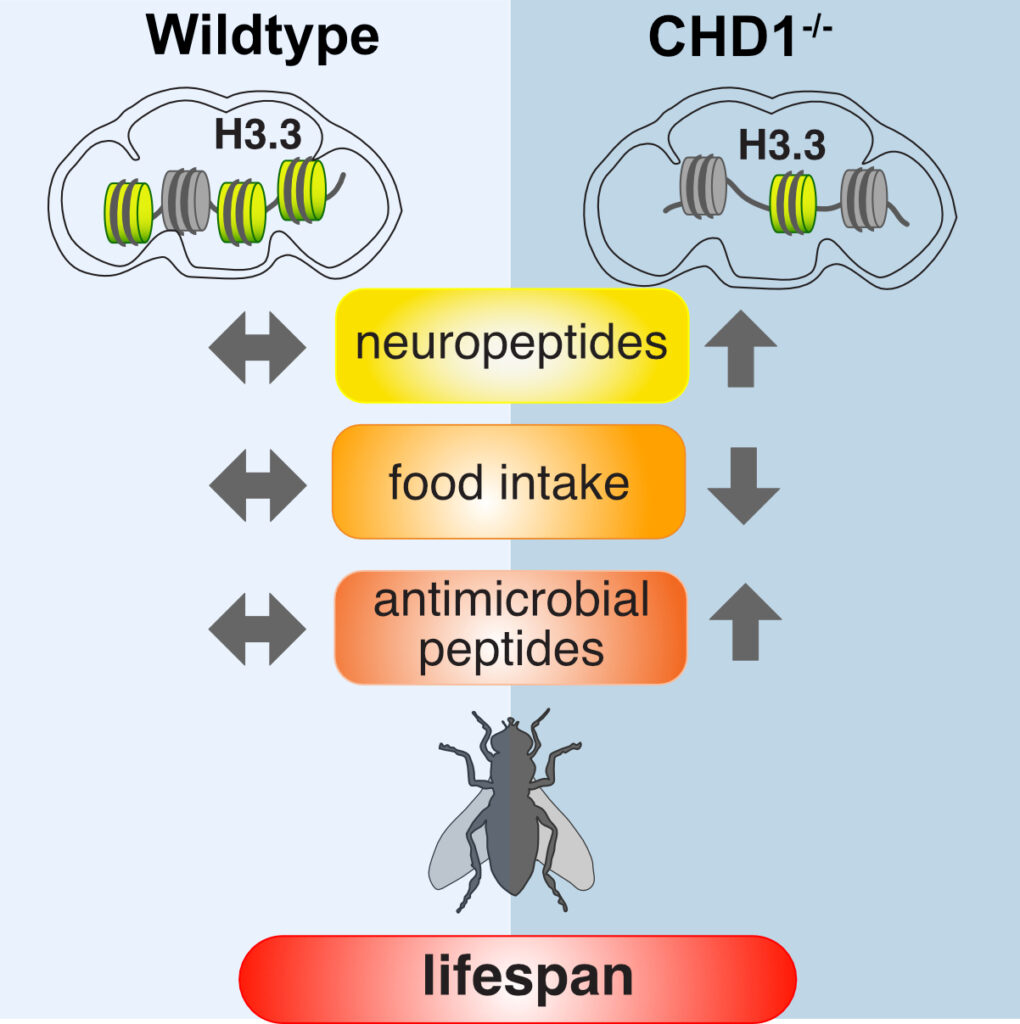
Future Goals
We will continue to explore age-related functions of CHD1 in Drosophila. Moreover, we will focus our research attention to the study of the biological significance of methyl-cytosine and other RNA modifications.
Pictures
Selected Publications
Aguiar, Mario; Orasch, Thomas; Shadkchan, Yana; Caballero, Paticia; Pfister, Joachim; Sastré-Velásquez, Luis Enrique; Gsaller, Fabio; Decristoforo Clemens; Osherov, Nir; Haas, Hubertus: Uptake of the Siderophore Triacetylfusarinine C, but Not Fusarinine C, Is Crucial for Virulence of Aspergillus fumigatus. MBIO. 2022;13(5):e0219222.
Misslinger, Matthias, Hortschansky, Peter; Brakhage, Axel A.; Haas, Hubertus: Fungal iron homeostasis with a focus on Aspergillus fumigatus. BIOCHIMICA ET BIOPHYSICA ACTA – MOLECFULAR CELL RESEARCH. 2021;1868(1):118885.
Sastré-Velásquez, Luis Enrique ; Dallemulle, Alex; Kühbacher, Alexander; Baldin, Clara; Alcazar-Fuoli, Laura; Niedrig, Anna; Müller, Christoph; Gsaller, Fabio: The fungal expel of 5-fluorocytosine derived fluoropyrimidines mitigates its antifungal activity and generates a cytotoxic environment. PLOS PATHOGENS. 2022; 18(12); e1011066;
Baldin, Clara; Kühbacher, Alexander; Merschak, Petra; Wagener, Johannes; Gsaller, Fabio: Modular Inducible Multigene Expression System for Filamentous Fungi. MICROBIOLOGY SPECTRUM. 2022;10(6):e0367022;
Moreno, Sarah; Fickl, Magdalena; Bauer, Ingo; Brunner, Melanie; Razkova, Anna; Rieder, Dietmar; Delazer, Isabel; Micura, Ronald; Lusser, Alexandra: 6-Thioguanosine monophosphate prodrugs display enhanced performance against thiopurine-resistant leukemia and breast cancer cells. JOURNAL OF MEDICINAL CHEMISTRY 2022 DOI: 10.1021/acs.jmedchem.2c01010.
Schoberleitner, Ines; Bauer, Ingo; Huang, Anming; Andreyeva, Evgeniya N.; Sebald, Johanna; Pascher, Katharina; Rieder, Dietmar; Brunner, Melanie; Podhraski, Valerie; Oemer, Gregor; Cazarez-Garcia, Daniel; Rieder, Leila; Keller, Markus A.; Winkler, Robert; Fyodorov, Dmitry, V; Lusser, Alexandra: CHD1 controls H3.3 incorporation in adult brain chromatin to maintain metabolic homeostasis and normal lifespan. CELL REPORTS. 2021; 37(1); 109769.
Holzknecht, Jeanett; Dubrac, Sandrine; Hedtrich, Sarah; Galgóczy, László; Marx, Florentine: Small, cationic antifungal proteins from filamentous fungi inhibit Candida albicans growth in 3D skin infection models. MICROBIOLOGY SPECTRUM. 2022; 10(3); e0029922.
Czajlik, Andras; Holzknecht, Jeanett; Galgoczy, Laszlo; Toth, Liliana; Poor, Peter; Ordog, Attila; Varadi, Gyorgyi; Kuehbacher, Alexander; Borics, Attila; Toth, Gabor K.; Marx, Florentine; Batta, Gyula: Solution structure, dynamics, and new antifungal aspects of the cysteine-rich miniprotein PAFC. INTERNATIONAL JOURNAL OF MOLECULAR SCIENCES. 2021; 22(3); 1183.
Karahoda, Betim; Pardeshi, Lakhansing; Ulas, Mevlut; Dong, Zhiqiang; Shirgaonkar, Niranjan; Guo, Shuhui; Wang, Fang; Tan, Kaeling; Sarikaya-Bayram, Özlem; Bauer, Ingo; Dowling, Paul; Fleming, Alastair B; Pfannenstiel, Brandon T; Luciano-Rosario, Dianiris; Berger, Harald; Graessle, Stefan; Alhussain, Mohamed M; Strauss, Joseph; Keller, Nancy P; Wong, Koon Ho; Bayram, Özgür: The KdmB-EcoA-RpdA-SntB chromatin complex binds regulatory genes and coordinates fungal development with mycotoxin synthesis. NUCLEIC ACIDS RESEARCH. 2022; 50(17); 9797-9813.
Bauer, Ingo; Graessle, Stefan: Fungal Lysine Deacetylases in Virulence, Resistance, and Production of Small Bioactive Compounds. GENE. 2021; 12(10); 1470.
Selection of Funding
Selection of Acquired Funding in 2021/2022/2023
P 35951 Stand-Alone Project Austrian Science Fund (FWF) to FG
P 33936 Stand-Alone Project Austrian Science Fund (FWF) to AL
Collaborations
- Laura Alcazar-Fuoli, Instituto de Salud Carlos III, Madrid, Spain
- Andreas Bernkop-Schnürch, University of Innsbruck, Innsbruck, Austria
- Axel Brakhage, F. Schiller University Jena, Germany
- Franz Bracher, LMU Munich, Munich, Germany
- Mike Bromley, The Manchester University, UK
- Florian Erhard, Julius-Maximilians-Universität Würzburg, Germany
- Dmitry Fyodorov, Albert-Einstein-College of Medicine, Bronx, USA
- László Galgóczi, University of Szeged, Hungary
- Ilse Jacobsen, Hans-Knöll Institut, Jena, Germany
- Nermina Malanovic, University of Graz, Graz, Austria
- Nir Osherov, Tel-Aviv University, Israel
- Alessandra Romanelli, University of Milan, Milan, Italy
- Özgür Bayram, Maynooth University, Maynooth, Ireland
- Joseph Strauss, BOKU, Vienna, Austria
